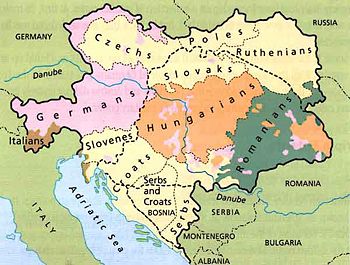Ausgleich
Ausgleich (German, "settlement" or "equalisation"; also known as the Austro-Hungarian Compromise of 1867) was the process which transformed the Austrian Empire into the Austro-Hungarian Empire in that same year.
Throughout the nineteenth century Magyar nationalists like Lajos Kossuth, Ferenc Deák and Gyula Andrássy had been calling for some form of Home Rule for Hungary within the broader Austrian Empire. A Hungarian regiment had fought with Prussia in 1866 and a revolt had spread throughout the Magyar lands with the defeat of the Austrians. Franz Joseph of Austria therefore decided to meet the Hungarian demands. The agreement which had been negotiated between Count Beust and Andrássy transformed the Empire into the dual monarchy of Austria-Hungary. The main points of the compromise were:
A) The two states were to have a common monarch, common military and naval departments, a common foreign policy and finance ministry. The system later became known as Dual Monarchy. Franz Joseph became King of Hungary as well as being the Emperor of the Empire.
B) Each State would have a separate parliament and Prime Minister. Sixty members of each were to form delegations, a body which would be summoned annualy by the Emperor to discuss affairs of State.
C) A Commercial Union that would be re-negotiated every ten years was to be agreed on.
